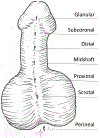Temporal, spatial, and genetic regulation of external genitalia development
- PMID: 31521888
- PMCID: PMC6878197
- DOI: 10.1016/j.diff.2019.08.003
Temporal, spatial, and genetic regulation of external genitalia development
Abstract
Fertilization requires the physical combination of gametes, and terrestrial mammals necessitated the evolution of genitalia capable of successfully completing the fertilization process in a non-aqueous environment. Thus, the male mammalian external genitalia evolved as an outgrowth from the body, an appendage sufficient to fertilize eggs housed deep inside the female. In this way, sexual dimorphism of mammalian genitalia became highly pronounced. This highly complex evolutionary divergence both from aqueous fertilization, as well as divergence between the sexes of terrestrial mammals, required exquisitely coordinated, novel patterns of gene expression to regulate the spatial and temporal events governing external genitalia development. Recent studies delineating the genetic regulation of external genitalia development, largely focusing on development of the murine genital tubercle, have vastly enlightened the field of reproductive developmental biology. Murine homologs of human genes have been selectively deleted in the mouse, either in the whole body or using tissue-specific and temporally-specific genetic drivers. The defects in outgrowth and urethral tubularization subsequent to the deletion of specific genes in the developing murine external genitalia delineates which genes are required in which compartments and at what times. This review details how these murine genetic models have created a somewhat modest but rapidly growing library of knowledge detailing the spatial-temporal genetic regulation of external genitalia development.
Keywords: Differentiation; Genitalia; Morphogen.
Copyright © 2019 International Society of Differentiation. Published by Elsevier B.V. All rights reserved.
Figures



Similar articles
-
Evolution of external genitalia: insights from reptilian development.Sex Dev. 2014;8(5):311-26. doi: 10.1159/000365771. Epub 2014 Aug 7. Sex Dev. 2014. PMID: 25115961 Review.
-
Multiphasic and tissue-specific roles of sonic hedgehog in cloacal septation and external genitalia development.Development. 2009 Dec;136(23):3949-57. doi: 10.1242/dev.042291. Development. 2009. PMID: 19906862 Free PMC article.
-
Functional and phylogenetic analysis shows that Fgf8 is a marker of genital induction in mammals but is not required for external genital development.Development. 2009 Aug;136(15):2643-51. doi: 10.1242/dev.036830. Development. 2009. PMID: 19592577 Free PMC article.
-
Bmp4 is an essential growth factor for the initiation of genital tubercle (GT) outgrowth.Congenit Anom (Kyoto). 2020 Jan;60(1):15-21. doi: 10.1111/cga.12326. Epub 2019 Feb 17. Congenit Anom (Kyoto). 2020. PMID: 30714224
-
Regulatory roles of epithelial-mesenchymal interaction (EMI) during early and androgen dependent external genitalia development.Differentiation. 2019 Nov-Dec;110:29-35. doi: 10.1016/j.diff.2019.08.004. Epub 2019 Sep 11. Differentiation. 2019. PMID: 31590136 Review.
Cited by
-
Differences in Formation of Prepuce and Urethral Groove During Penile Development Between Guinea Pigs and Mice Are Controlled by Differential Expression of Shh, Fgf10 and Fgfr2.Cells. 2025 Feb 27;14(5):348. doi: 10.3390/cells14050348. Cells. 2025. PMID: 40072077 Free PMC article.
-
One Tool for Many Jobs: Divergent and Conserved Actions of Androgen Signaling in Male Internal Reproductive Tract and External Genitalia.Front Endocrinol (Lausanne). 2022 Jun 30;13:910964. doi: 10.3389/fendo.2022.910964. eCollection 2022. Front Endocrinol (Lausanne). 2022. PMID: 35846302 Free PMC article. Review.
-
Streamlined identification of clinically and functionally relevant genetic regulators of lower-tract urogenital development.Proc Natl Acad Sci U S A. 2024 Feb 6;121(6):e2309466121. doi: 10.1073/pnas.2309466121. Epub 2024 Feb 1. Proc Natl Acad Sci U S A. 2024. PMID: 38300866 Free PMC article.
-
Microphallus early management in infancy saves adulthood sensual life: A comprehensive review.World J Clin Pediatr. 2024 Jun 9;13(2):89224. doi: 10.5409/wjcp.v13.i2.89224. eCollection 2024 Jun 9. World J Clin Pediatr. 2024. PMID: 38947989 Free PMC article. Review.
-
Elevated plasma miR-210 expression is associated with atypical genitalia in patients with 46,XY differences in sex development.Mol Genet Genomic Med. 2022 Dec;10(12):e2084. doi: 10.1002/mgg3.2084. Epub 2022 Nov 11. Mol Genet Genomic Med. 2022. PMID: 36369742 Free PMC article.
References
-
- Anderson C & Stern CD (2016) Organizers in Development. Curr Top Dev Biol, 117, 435–54. - PubMed
-
- Avendaño A, Paradisi I, Cammarata-Scalisi F & Callea M (2018) 5-α-Reductase type 2 deficiency: is there a genotype-phenotype correlation? A review. Hormones (Athens), 17, 197–204. - PubMed
-
- Baetens D, Verdin H, De Baere E & Cools M (2019) Update on the genetics of differences of sex development (DSD). Best Pract Res Clin Endocrinol Metab. - PubMed
-
- Baskin L (2017) What Is Hypospadias? Clin Pediatr (Phila), 56, 409–418. - PubMed
-
- Bischoff A, Trecartin A, Alaniz V, Hecht S, Wilcox DT & Peña A (2019) A cloacal anomaly is not a disorder of sex development. Pediatr Surg Int. - PubMed
Publication types
MeSH terms
Substances
Grants and funding
LinkOut - more resources
Full Text Sources

